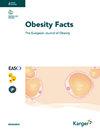Long-term change in BMI for children with obesity treated in family-centered lifestyle interventions.
IF 4.7
3区 医学
Q2 ENDOCRINOLOGY & METABOLISM
引用次数: 0
Abstract
Introduction Several evaluations of lifestyle interventions for childhood obesity exist; however, follow-up beyond two years is necessary to validate the effect. The aim of the present study was to investigate long-term weight development following children participating in one of two pragmatic family-centered lifestyle interventions for children with obesity. Methods This real-life observational study included Danish children 4-17 years of age classified as having obesity. Data from 2010-2020, from two community-based family-centered lifestyle interventions (designated hereafter as the Aarhus- and the Randers-intervention) were merged with national registers and routine health check-ups, including height and weight. Adjusted mixed effect models were used to model changes in Body Mass Index (BMI) z-score. We performed exploratory analyses of the development in BMI z-score within stratified subgroups of children treated in the interventions before investigating potential effect modifications induced by sex, age, family structure, socioeconomic or immigration status. Results With a median follow-up of 2.8 years (interquartile range: 1.3;4.8), 703 children participated in an intervention (445 the Aarhus-intervention; 258 the Randers-intervention) and 2,337 children were not invited to participate (no-intervention). Children in both interventions experienced a comparable reduction in BMI z-scores during the first 6 months compared to the no-intervention group (Aarhus-intervention: -0.12 SD/year and Randers-intervention: -0.25 SD/year). Only children in the Randers-intervention reduced their BMI z-score throughout follow-up (Aarhus-intervention vs. no-intervention: 0.01 SD/year; CI:-0.01;0.04; Randers-intervention vs. no-intervention: -0.05 SD/year; CI:-0.08;-0.02). In a subgroup comparisons combining the two interventions, family income below the median (-0.05 SD/year, CI: -0.02;-0.09), immigrant background (0.04 SD/year, CI: 0.00; 0.07), or receiving intervention less than one year (0.04 SD/year, CI: 0.00;0.08) were associated with a yearly change in BMI z-score. In addition, effect modification analyses did not observe any interaction by sex, age, family structure, socioeconomic or immigration. Conclusions Although the more dynamic intervention with longer duration obtained and sustained a minor reduction in BMI z-score, the clinical impact may only be modest. However, this effect may at the best be only modest and still not effective enough to induce a long-term beneficial development in BMI in children with obesity.在以家庭为中心的生活方式干预中接受治疗的肥胖症儿童体重指数的长期变化。
导言:目前已有多项针对儿童肥胖症的生活方式干预措施的评估;然而,有必要进行两年以上的随访,以验证其效果。本研究旨在调查儿童在参加两种以家庭为中心、针对肥胖症儿童的务实生活方式干预后的长期体重发展情况。方法 这项现实生活观察研究包括被归类为肥胖症的 4-17 岁丹麦儿童。研究人员将 2010-2020 年期间来自两个以社区为基础、以家庭为中心的生活方式干预项目(以下分别称为 "奥胡斯干预项目 "和 "兰德斯干预项目")的数据与国家登记册和常规健康检查(包括身高和体重)的数据进行了合并。调整后的混合效应模型用于模拟身体质量指数(BMI)z-分数的变化。在调查性别、年龄、家庭结构、社会经济状况或移民状况可能引起的影响变化之前,我们对接受干预治疗的儿童分层分组的 BMI zcore 变化情况进行了探索性分析。结果 在中位 2.8 年(四分位数间距:1.3;4.8)的随访中,703 名儿童参加了干预(445 名参加了奥胡斯干预;258 名参加了兰德斯干预),2337 名儿童未被邀请参加(未参加干预)。与未参加干预的儿童相比,参加这两项干预的儿童在头6个月中的体重指数z值下降幅度相当(奥胡斯干预:-0.12标准差/年,兰德斯干预:-0.25标准差/年)。在整个随访过程中,只有兰德斯干预组的儿童降低了体重指数(BMI)z-分数(奥胡斯干预组与未干预组相比:0.01 SD/年;CAR:0.01 SD/年;CAR:0.01 SD/年):0.01标准差/年;CI:-0.01;0.04;兰德尔干预与非干预相比:-0.05标准差/年;CI:-0.08;-0.02)。在综合两种干预措施的亚组比较中,家庭收入低于中位数(-0.05 SD/年,CI:-0.02;-0.09)、移民背景(0.04 SD/年,CI:0.00;0.07)或接受干预不足一年(0.04 SD/年,CI:0.00;0.08)与体重指数 Z 值的年变化相关。此外,效果修正分析没有观察到性别、年龄、家庭结构、社会经济或移民的交互作用。结论 虽然持续时间更长的动态干预措施能使体重指数 Z 值略有下降,并能持续下去,但其临床影响可能不大。不过,这种影响最多也只是轻微的,仍不足以使肥胖儿童的体重指数得到长期有益的发展。
本文章由计算机程序翻译,如有差异,请以英文原文为准。
求助全文
约1分钟内获得全文
求助全文
来源期刊

Obesity Facts
医学-内分泌学与代谢
CiteScore
6.80
自引率
5.60%
发文量
77
审稿时长
6-12 weeks
期刊介绍:
''Obesity Facts'' publishes articles covering all aspects of obesity, in particular epidemiology, etiology and pathogenesis, treatment, and the prevention of adiposity. As obesity is related to many disease processes, the journal is also dedicated to all topics pertaining to comorbidity and covers psychological and sociocultural aspects as well as influences of nutrition and exercise on body weight. The editors carefully select papers to present only the most recent findings in clinical practice and research. All professionals concerned with obesity issues will find this journal a most valuable update to keep them abreast of the latest scientific developments.
 求助内容:
求助内容: 应助结果提醒方式:
应助结果提醒方式:


